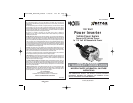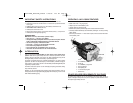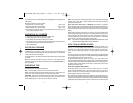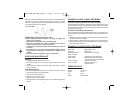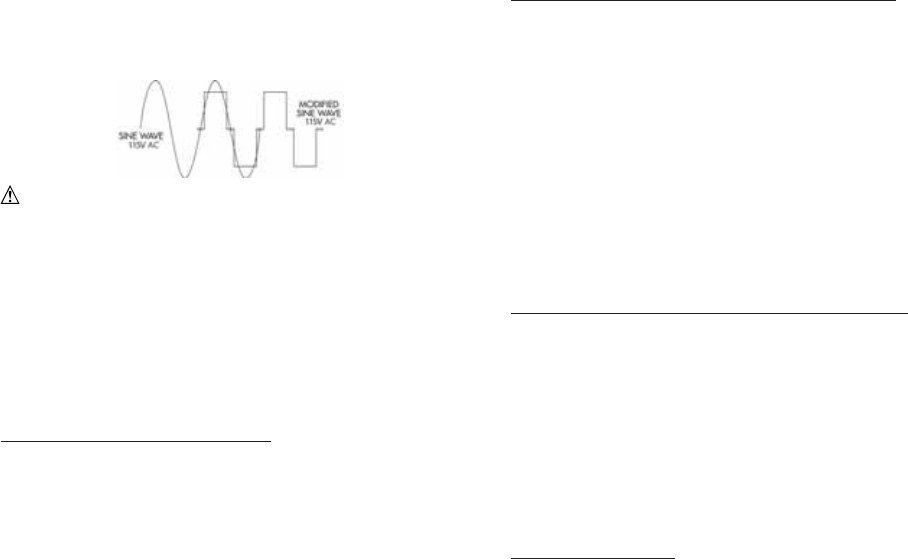
COMMON AUDIO/VISUAL PROBLEMS
Problem: Buzzing Sound In Audio Systems
Some inexpensive stereo systems and boom boxes make a buzzing sound when operated from the
inverter, because the power supply in the electronic device does not properly filter the modified
sine wave produced by the inverter. The only solution to this problem is to use a sound system that
has a higher quality power supply.
Problem: Television Interference
The inverter is shielded to minimize interference with TV signals. However, in some instances, some
interference may still be visible, especially when the TV signal is weak. Try the following to improve
the picture:
1. Move the inverter as far away as possible from the TV set, the antenna, and the antenna cables.
Use a short AC extension cord, if necessary.
2. Adjust the orientation of the antenna cables, and the TV power cord to minimize interference.
3. Make sure the antenna feeding the TV provides an adequate (snow free) signal and that high
quality, shielded antenna cable is used.
COMMON POWER OUTPUT PROBLEMS
Possible Causes Recommendations
Battery voltage Recharge battery or check
below 10 volts. DC power supply.
Equipment being operated Reduce load to maximum 100 watts.
draws too much power.
Inverter in thermal Allow inverter to cool down. Ensure there is
shutdown condition. adequate ventilation around unit, and load is
no more than 100 watts for continuous operation.
Main fuse failed (blown). Replace fuse in DC connector.
Inverter is overloaded. Reduce load to 100 watts max.
to maintain regulation.
SPECIFICATIONS
Power : 100 watts
AC Output: 115 volts, 60 Hz
DC Input: 13.8 volts
Fuse: 10 amps
Waveform: Modified Sine Wave
meters will not correctly read the RMS voltage of a modified sine wave. Non-TRUE RMS meters will
read about 20 to 30 volts low when measuring the output of this inverter. For accurate
measurement of the output voltage of this unit, use a TRUE RMS reading voltmeter such as a Fluke
87, Fluke 8080A, Beckman 4410, or Triplett 4200.
115 volt AC Output
CAUTION: Rechargeable Devices
• Certain rechargeable devices are designed to be charged by plugging them
directly into an AC receptacle.
• These devices may damage the inverter or the charging circuit.
• When using a rechargeable device, monitor its temperature for the initial ten
minutes of use to determine if it produces excessive heat.
• If excessive heat is produced, this indicates the device should not be used with
this inverter.
• This problem does not occur with most battery-operated equipment. Most of
these devices use a separate charger or transformer that is plugged into an AC
receptacle.
• The inverter is capable of running most chargers and transformers.
CARE AND MAINTENANCE
Storage
1. Ideal storage temperature range is 50-68°F (10-20°C).
2. Store and use the inverter in a cool, dry place with adequate ventilation for all-around air
circulation.
3. Avoid locations that are exposed to heating units, radiators, direct sunlight, or excessive
humidity or dampness.
Fuse Replacement
If the inverter is overloaded, and the green LED is not lit, the internal 10 amp fuse may be blown.
1. Unscrew the flange of the inverter (counterclockwise).
2. Remove the end contact, flange and fuse.
3. Inspect the fuse to see if it is good or blown.
4. Replace with a new 10 amp fuse, if needed.
5. Carefully reassemble the fuse, end contact and flange. Do not overtighten the flange (turning
clockwise).
6 7
VEC1040AMG_ManualEN_022806 2/28/06 4:15 PM Page 6



